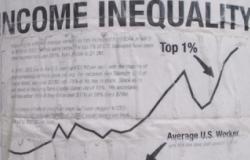
In October, the World Bank released its 2014 Global Monitoring Report (GMR). The annual GMR is a flagship report produced by the World Bank and the International Monetary Fund (IMF) that traditionally offers an update on the progress of the Millennium Development Goals. In a bit of a twist, the aim of this year's report is to assess the World Bank's broad goal of seeing shared prosperity increase in all countries. This is a worthy intention, but how can we measure whether shared prosperity is rising? The indicator developed by the World Bank measures the income (or consumption) growth of the poorest 40 per cent and compares it to the growth of the whole country over a five year period. If the bottom 40 per cent fared better than the whole country, the World Bank declares shared prosperity is on the rise. This year's GMR calculates data for 86 countries between 2006 and 2011. According to the results, the bottom 40 per cent fared better than the average in 58 of the countries (67 per cent), leading the World Bank to declare shared prosperity is rising globally. Below, I argue for why this is an inadequate indicator. Instead, I recommend the World Bank compare changes in growth between the poorest 40 per cent and richest 10 per cent, or fewer.